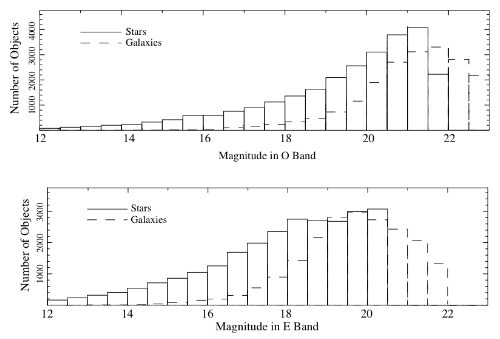Object Classification
We use an artificial neural network (ANN) classifier (Odewahn et al. (1992, 1993) and Odewahn (1995)) to classify each image as either a star or a non-stellar image (galaxy) (non-stellar). The images are independently classified on both the O and E plates, but the O-plate classification is preferred and is used in the database because it gives a higher success rate and has shown better repeatability. Our first ANN classifier yielded a success rate above 90% down to 20.0 - 20.5 mag for stars, and 19.5 mag for galaxies. But for objects fainter than 19.5 - 20th magnitude, it was an extrapolation of networks trained on brighter objects. We now use an ANN trained to the plate limit using fainter known galaxies from the Infante & Pritchet (1992) catalog of galaxies at the NGP. This improved network yields a success rate better than 96% for both stars and galaxies with image diameters greater than 4:00.9 or ∼ 21st magnitude for the O plate and ∼80% success for smaller images down to our processing limit at about 1:00.7. Figure 3 shows the number of stars and galaxies as a function of magnitude for the NGP field P323.
The neural network has two output nodes, one for galaxies and one for stars. The value at each is a measure of the probability that the image is an object of that class, and the sum of the two node values is unity. The "galnode" parameter is the value from the galaxy node and is included in the database. When galnode from the O plate exceeds 0.50, the image is classified as a galaxy. Obviously galnode values near 0.50 indicate that the classification is uncertain. In this two-class system, blended or merged images are almost always classified as galaxies (non-stellar). This can be a problem for fields near the Galactic plane where the density of images is high (see Larsen & Humphreys (2003)).
Based on the ANN classifier, the 89,234,404 objects in the Catalog consist of 56,391,694 "stars" and 32,842,710 non-stellar objects or "galaxies".

